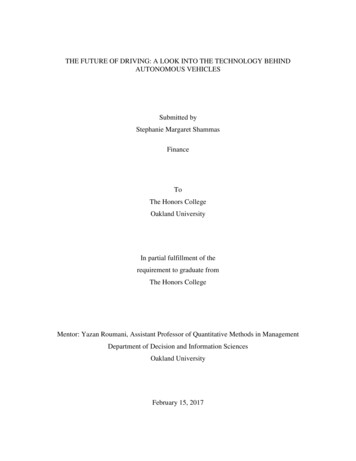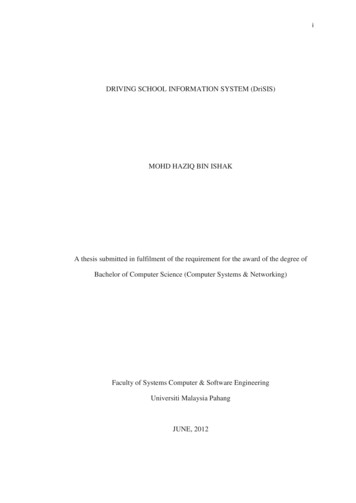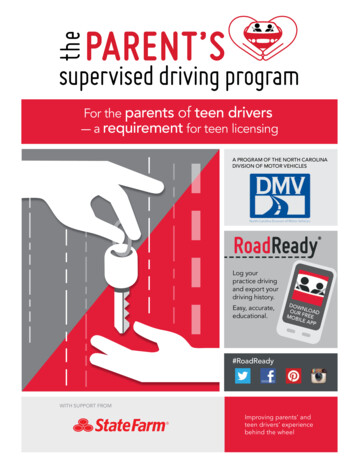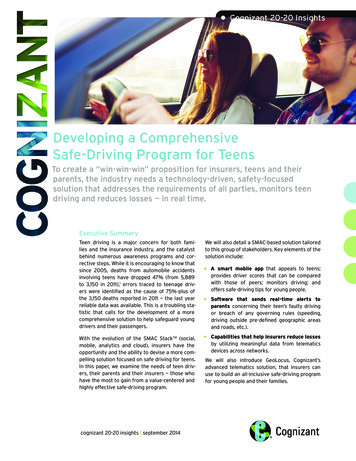
Transcription
THE FUTURE OF DRIVING: A LOOK INTO THE TECHNOLOGY BEHINDAUTONOMOUS VEHICLESSubmitted byStephanie Margaret ShammasFinanceToThe Honors CollegeOakland UniversityIn partial fulfillment of therequirement to graduate fromThe Honors CollegeMentor: Yazan Roumani, Assistant Professor of Quantitative Methods in ManagementDepartment of Decision and Information SciencesOakland UniversityFebruary 15, 2017
IntroductionImagine how life would be like if a car could simply drive its passengers aroundanywhere they wanted to go without any manual control. Passengers would not have to worryabout controlling the steering wheel, paying attention to the roads, slowing down, braking, oreven knowing any directions. They would not have to worry about a pedestrian suddenly runningout in front of the vehicle, or if a sudden traffic jam causes a horrific accident because they couldnot stop in time. Passengers would be able to catch up on sleep, eat, watch a movie, or even reada book, as the car fully operates by itself and drives them safely to their destination. All of thesedifferent scenarios introduce the new idea of an autonomous, or self-driving, car. By definition,an autonomous car is a vehicle that is capable of sensing its environment and navigating withoutany human input. It is able to detect its surroundings using a variety of techniques includingRadar, Laser Illuminating Detection and Ranging (LIDAR), GPS and computer vision (Wright2015). An autonomous vehicle is essentially a “smart” car that would be able to constantly detectits surroundings and safely prevent passengers from encountering any incidents. It would sensean upcoming road blockage or traffic jam from miles away. It would be familiar with itsenvironment and quickly react to and prevent any sudden driving encounters. It would alert thepassengers if there is an emergency, and more importantly, it would help prevent numerous carcrashes that occur every single day. As impossible as this may sound, autonomous vehicles havequickly become a reality. “Google says that driverless cars will dominate the roadways in thenear future and that 90% of the 1.2 million global fatalities due to auto accidents could beavoided with driverless cars” (McDonald 2013). From this day forward, the powerful technologybehind autonomous vehicles could eventually change the world.2
Autonomous vehicles would be an improved resource for those who are not physicallycapable of driving a vehicle. The technology would be so intelligent and dominant that anincapable individual could simply sit in the car and arrive safely to their destination. Technologyis very powerful nowadays, and this revolutionary idea could actually become a reality one day.In fact, it already has become part of our reality in 2016. Recently, there have been manymanufacturers and automotive companies that have begun the process of creating autonomousvehicles. Companies like Tesla, Google, BMW, Ford and Delphi, have even begun testing theirvehicles on roads to see how well the vehicle interacts with different environments. Othercompanies have even proposed timelines as to when their self-driving vehicles will be availableto the public. A recent article from MIT stated that “Ford and BMW have promised to have anentirely autonomous vehicle on the road by 2021” (Condliffe 2016). Additionally, Nissan hasalso announced that they will be introducing a “revolutionary, commercially-viable autonomousdrive in multiple vehicles by the year 2020” (McDonald 2013). It is extraordinary to think that inless than a few years, autonomous cars will be available to the public and could eventuallydominate the automotive industry, changing the lives of millions of drivers. With all the researchand technology that is accessible today, there is no doubt that autonomous vehicles are going tohave a huge impact on humans and change the future of driving.Current ResearchThere is an abundance of research as well as discussion about how future advancementsin technology will eventually transform the automotive industry. According to McDonald, therehave been many improvements made to radars, cameras, and motion sensors, in order to createautonomous vehicles (McDonald 2013). McDonald mentions how self-driven cars willeventually take over the automotive industry within the next decade, due to the new3
technological innovations. However, for this to happen, there will need to be significant changesmade to normal vehicles. For example, manufacturers of these autonomous vehicles would needto enhance the connectivity and sensors of the car, so that it can be programmed to think andreact accordingly. One article titled “Self-Driving Cars,” explains how some autonomousvehicles use Advanced Driver Assist Systems (ADAS), which basically uses “a combination ofadvanced sensors, such as stereo cameras and long- and short-range radar, combined withactuators, control units, and integrating software, to enable cars to monitor and respond to theirsurroundings.” In other words, an autonomous car would need to have the technologicalintelligence and capability to think and navigate entirely on its own.Furthermore, there have been a few institutions that have started to test their autonomousvehicles by creating real-life driving scenarios. For example, The University of Michigan hasrecently created what is known as Mcity, which is a “32-acre microcosm of motoring completewith faded stop signs, roundabouts, lousy weather and out-of-date traffic signals” (Shankland2015). They are creating their own autonomous operating system and testing it in within theirinstitution. Mcity is ultimately trying to see if the cars can overcome even the most difficultdriving scenarios, so that they can determine how to further improve upon them.There are also data reports published by various companies working on autonomoustechnology, such as Google and Delphi, that provide autonomous driving data, including theautonomous vehicle’s average miles driven, the number of emergencies encountered, and theoverall disengagement conditions of the vehicles. The Department of Motor Vehicles (DMV)defines a disengagement as the time when “a failure of the autonomous technology is detected,”and also “when the safe operation of the vehicle requires that the autonomous vehicle test driverdisengages the autonomous mode and takes immediate manual control of the vehicle” (“Google4
Self-Driving Car Testing Report ”). Examining the vehicle’s disengagement report wouldprovide a tremendous amount of feedback to the manufacturers, especially when it comes toidentifying and improving the overall causes of the disengagement. Ultimately, this data couldhelp in significantly reducing the number of faults that autonomous cars currently incur.Disadvantages of Autonomous VehiclesAlthough there have been countless discussions about the benefits of autonomousvehicles, there is still a large cloud of criticism surrounding this new technology. Sinceautonomous driving is a very new concept, it would be a tremendous change in the lives of manydrivers. A large number of people are opposed to self-driving cars simply due to thepreconceived notion that they are still a technological product, and therefore, could be subject tohazardous defects, especially when they are meant for everyday driving. Automakers are tryingto make autonomous vehicles as flawless and as harmless as possible. The whole idea behind aself-driven car would be to program the vehicle exquisitely so that it could detect and be alert toevery possible act of danger there could be while driving, while ensuring passengers simplyremain seated in the vehicle. According to the article “Long Road Ahead,” around “65% of the1,000-plus consumers surveyed felt self-driving vehicles were an ‘extremely dangerous idea’”(Kinkhammer 2015). That small survey alone is concerning to automakers, since they want theircustomer base to eventually be everyday drivers. To add to this, there has been more talk aboutthe negative impacts of autonomous vehicles not only from consumers, but also from severaldifferent industries. One theory suggests that once autonomous vehicles are introduced in themarket, they could negatively affect the economy and certain industries within it, such asinsurance companies. Kinkhammer states that the costs of autonomous vehicles will cause “aneconomic stimulus of around two trillion dollars a year” (Kinkhammer 2015). This is due to the5
fact the vehicles will ultimately help reduce collisions, therefore minimizing the need of moreparamedic assistance, auto repair shops, and more importantly, insurance companies. This wouldresult in a massive unemployed population, and all of the companies associated with automobileswould undeniably lose significant amounts of money. Also, if autonomous vehicles help reduceaccidents with other vehicles and objects on the road, the demand for car parts and vehiclemaintenance would significantly decrease, ultimately leaving a huge negative impact on theeconomy.Many people also are hesitant about autonomous vehicles due to the fact that the vehicleis essentially a robot that is replacing a human driver. Driving is already considered a riskyactivity; many people would agree that putting their lives in the hands of a robot is not safe, astechnology may be unpredictable and can often malfunction. Although many uncertaintiessurrounding autonomous vehicles exist, there are more benefits than risks. This paper willmainly explore the benefits of having autonomous vehicles in the market and further explain thetechnology that creates these extraordinary systems.Background of Autonomous VehiclesIt is extremely important for drivers to learn more about the technological changes beingmade to normal vehicles. This will help familiarize them with the technology behind autonomousvehicles, understand how the car will essentially operate by itself, and see how it will affect theirtravel in the future. This paper will explore the technology and software behind Google,Autonomous Vehicle Systems and Delphi’s autonomous vehicles.Many people are not aware of that fact that technological creators of self-driven vehiclesare using the same software and technology that is currently being used on the road in normalvehicles (Clark 2015). When people think of autonomous vehicles, they believe that automakers6
are using an entirely different, non-tested software that might not necessarily be safe. However,this is not the case whatsoever. Automakers are using the same safe and tested technology that’scurrently used in a non-autonomous vehicle, and they are simply tweaking the mechanicalaspects and software, in order to make the vehicle fully autonomous.A Look into Google’s Autonomous TechnologyThe technology used in a typical autonomous vehicle will be very similar; however, eachcompany that invests in the creation of a self-driving vehicle will have their own uniqueoperating system. First, it is extremely important for an autonomous vehicle to have a set ofcameras around its entire body. This is essentially how the vehicle would be aware of itssurroundings, and more importantly, be able to react accordingly within its environment.According to an article by Clark, “one of Google’s prototypes uses cameras mounted to theexterior with slight separation in order to give an overlapping view of the cars’ surroundings”(Clark 2015). Clark also explains how the majority of the cameras on Google’s vehicles wouldhave a 50-degree field of view and would ultimately be accurate to about 30 meters. In additionto cameras, an autonomous vehicle would require a unique programmed software to properlyfunction. Google’s software includes a combination of Laser Illuminating Detection and Ranging(LIDAR), sonar, radar, and positioning. LIDAR has a 3-D map and allows the vehicle to “see”any potential hazards before them. This process occurs by “bouncing a laser beam from surfacessurrounding the car in order to accurately determine the distance and the profile of that object”(Clark 2015). The LIDAR system is currently being used in Google’s self-driven car, and “it canaccurately see up to a range of 100 meters, using a Velodyne 64-laser beam that rotates 360degrees, taking up to 1.3 million readings per second” (Whitwam 2014). This laser machine thatis being used by Google is placed on top of the vehicle and it must be linked up to the “brain” of7
the vehicle. LIDAR has a very detailed preloaded map that includes all of the traffic signals andlights, followed by any crossways that are around the area. Figure 1 below shows what theLIDAR system currently looks like on Google’s autonomous vehicle.Figure 1: Google’s current LIDAR systemSource: Bryan Clark: “How Self-Driving Cars Work: The Nuts and Bolts Behind Google’s Autonomous Car Program”In addition to LIDAR, radar technology would be used to monitor the speed of all thesurrounding vehicles while driving. The way the radar works is that the vehicle would have atotal of four bumper-mounted radar units on both the front and rear bumpers, allowing the car tosense its surroundings and alert the on-board processor, also known as the “brain” of the vehicle,to either apply the brakes or to move into a separate lane or available area in order to safelyavoid any collisions (Clark 2015). Google’s radar system can detect surroundings up to 200meters away, while their sonar can only detect up to 6 meters away (Whitwam 2014). Both radarand LIDAR would work closely together to cautiously map out all of the vehicle’s surroundings,and automatically apply either pre-tension on the seatbelts or the brakes in case of an emergency.8
LIDAR and radar ultimately work together to help ensure that the vehicle is alert and ready totake action, in case of an unexpected situation.The Positioning and GPS software technology has been greatly improved for autonomousvehicles as well. Google has created their very own map positioning system that includes GPSsatellites, inertial measurement units, their unique map system, and a wheel encoder to accuratelydetermine the speed of the autonomous vehicle, as well as the vehicles around it (Clark 2015).This entire positioning system works with the cameras embedded on the vehicle, so that it maydetermine the precise location of all other vehicles, “down to a few centimeters,” as well as howfar away the next stoplight or traffic signal is (Clark 2015). Google’s positioning technology isso advanced that it also processes real-world information from the cameras so that the vehicle ismade aware of any sudden changes while driving, such as unexpected road blockage or anyaccidents. Furthermore, the vehicle’s software allows it to properly make adjustments to thesechanges on its own, upon initial detection (Clark 2015). In addition, Google’s autonomousvehicles include a high-resolution video camera inside the car, which helps detect pedestrians,bicyclists, traffic signals, as well as any other moving obstacles. Along with its GPS system, ittracks any object’s position with an inertial motion sensor (Brown 2011). This is extremelyhelpful for the vehicle when it is driving, since it will need to know the speed and placement ofother objects and vehicles within its vicinity.The software behind autonomous vehicles is both unique and sophisticated enough toallow the vehicle to continuously learn and process countless situations that it encounters whiledriving. Google has programmed its autonomous vehicle to obey simple driving etiquettes suchas stopping at red lights, slowing down at yellow lights, and signaling if it wants to turn eitherright or left (Clark 2015). However, each time the vehicle is driven, all the miles are logged, and9
all the information from any incidents that were picked up while driving are all stored so that thevehicle is able to learn and adapt to any similar incidents in the future. Not only does thesoftware allow the autonomous vehicle to process and store data from its own drivingencounters, but it also is programmed to monitor and process the behavior of other drivingvehicles surrounding it. The software uses a technique called behavioral dynamics, which is adescriptive analysis of the behavioral patterns that cause certain external behavior (“What isBehavioral Dynamics?”). In other words, Google’s sophisticated software has the ability to learnand recognize the behavior of other vehicles while driving, and it can process all of that data inorder to quickly recognize and find the most appropriate response to each of the problems thatthe vehicle encounters. According to Clark, the cars are able to recognize and acclimate to thefollowing situations: a pot hole or any type of foreign object in the street that would cause adriver to swerve, a slow-moving car in the right lane suggesting that the vehicle behind it willspeed up to try to pass this car in the left lane, or if a vehicle suddenly signals that they want toturn right and brakes immediately, there is a high probability that the vehicle behind would try toswerve into the other lane so that it would not have to slam on its brakes or reduce its speed(Clark 2015). This software is basically allowing the vehicle to establish its own memory,therefore, relying on only itself and its experiences, to properly navigate autonomously.The technology behind self-driven vehicles must be so precise and accurate since it issubstituting the physical presence of a human behind the steering wheel. In normal vehicles,humans are the ones with the “cameras” in their eyes, watching the road and reactingaccordingly. The human brain processes the information from previous and current scenarios,and decides how to react to the different environmental conditions. Humans decide whichdirection to take and they use their hands and legs to control their vehicle. A car is essentially a10
machine that does not work unless someone physically turns it on and directs its every move.The purpose of an autonomous vehicle is to eliminate the human operation side, by simplyallowing the vehicle to act just as a human would and ultimately operate by itself. This furthersupports the idea that both the software and technology behind autonomous vehicles must bevery intelligent and reliable in order to prove to the public just how safe this technology is.Each manufacturer of autonomous cars may have some differences when it comes to thetype of software and technology that they want to use. By examining how Google is currentlydeveloping software for their cars, one can see that the most crucial pieces of technology in selfdriven cars is the use of LIDAR, radar and sonar technology. This next section will furtherinvestigate what another manufacturer, Autonomous Vehicle Systems, is creating in their versionof this vehicle.A Look into Autonomous Vehicle System’s Autonomous TechnologyAutonomous Vehicle Systems (AVS) is a team of industry professionals and scientificresearchers with expertise in advanced sensor development, unmanned aerial vehicle (UAV)development, autonomous navigation and control, software development, and high performancevehicle modifications (Autonomous Vehicle Systems). They are primarily a research companylocated in San Diego, California. When it comes to their work on autonomous vehicles, theirtechnology is very similar to Google; however, they have their unique differences. In addition toLIDAR, radar, cameras, and sensors, AVS uses its own unique computation, actuation, andnavigation systems (Autonomous Vehicle Systems). The computation system, or the “brain,” isreferred to as the Vehicle Autonomous Management Processors In Real-time Environments(VAMPIRE), and it consists of “9 high-speed processors interconnected by the fastest networksystem available today” (Autonomous Vehicle Systems). These nine processors each focus on a11
different task; for example, making the vehicle move a certain direction, processing sensor dataand determining how to respond, or even mapping out directions for the vehicle to follow. AVSalso developed a Base Autonomous Test System (BATS), which is used to monitor the vehiclewhile it’s in operation. BATS monitors the health of any component of the vehicle, and thesystem sensors provide live feedback to the vehicle, making it aware of any issues. BATS alongwith the VAMPIRE system both work together in order to ensure safe and smooth driving. “TheVAMPIRE system manipulates a series of actuators and relays that can control the vehicle”(Autonomous Vehicle Systems). Just like in a normal vehicle, the driver would control thesteering wheel, brakes, and gas pedal; however, the actuation system in AVS self-driven carswould control everything all by itself, eliminating the need for a human driver. Finally, for theirnavigation systems, AVS, like Google, uses Global Positioning System (GPS) in order todetermine the precise position of each vehicle using the constellation of satellites currentlyorbiting the Earth. In addition to GPS, they also use Inertial Navigation Systems (INS), in orderto determine the exact vehicle position, proving to be extremely helpful in times where the GPScoverage is lost due to environmental factors (Autonomous Vehicle Systems). According to theAVS website, there have been recent developments to mm-wave Radar scanning, which willhelp to avoid collisions due to obscured weather such as dust, smoke, fog, snow, etc.Environmental factors play a huge role in autonomous driving. For the vehicle to have the abilityto sense certain weather or environmental conditions, and not have them negatively affectdriving is a huge benefit to both the automakers and the consumers of these vehicles. For themost part, the technology and software behind autonomous vehicles is primarily the same,however, depending on each manufacturer, there will be slight differences, and it is important fordrivers and the public to be aware of these differences to see how and what is being done to12
transform normal vehicles into autonomous vehicles. In this next section, we will explore onelast manufacturer, Delphi Automotive, and see how their autonomous technology compares toboth Autonomous Vehicle Systems and Google.A Look into Delphi Automotive’s Autonomous TechnologyDelphi Automotive PLC is a high-technology automotive supplier that integrates safer,greener, and more connected solutions for the automotive sector. Currently, Delphi only createsthe technology and partners with software companies in developing the entire autonomousoperating system, so that they can eventually sell to automakers, as the company will not beselling autonomous vehicles under their own name (Krok 2016). Being the 12th largest globalOEM automotive supplier, and a world leader in automated driving software, sensors, andsystems integration, Delphi has more than half-century’s worth of experience with the uniquetechnology that is used in autonomous driving. They are also the world’s first supplier to have afully autonomous vehicle to have completed a coast-to-coast trip across the United States, in thesummer of 2016. Needless to say, Delphi is certainly on the verge to success in the automotiveindustry. When examining the software and technology that Delphi uses on its autonomousvehicle system, it has some similarities to the software and technology of both Google andAutonomous Vehicle Systems. Delphi’s CEO, Kevin Clark, states in an interview that Delphidefines the words “active safety” by their current radar and vision systems, used on normalvehicles, but not yet LIDAR—which will however be ready in 2019 (Sedgwick 2016). He alsomentions that those same three sensors, vision, radar, and LIDAR, are the main componentsneeded for an autonomous vehicle to operate on its own, and will be added to Delphi’sautonomous vehicle system. Clark adds that Delphi’s “sweet spot” is in vehicle-to-vehicle(V2V), and vehicle-to-infrastructure (V2I), and this has already given the company a slight13
advantage when it comes to developing the high-technology behind these self-operating cars(Sedgwick 2016). The way that Delphi’s current wireless vehicle communication technologyworks is that it “extends the range of existing advanced driver-assistance-system functionality,using radio signals to transmit traffic data from vehicle to vehicle to alert drivers of potentialroad hazards (Amend 2014). The software behind the vehicle would be able to detect and alertthe passengers of any danger ahead. Delphi also provides both radar and vision systems, such asadaptive cruise control and lane-keeping (Amend 2014). However, the major attribute that islacking with Delphi’s current technology for normal vehicles, is of course the autonomousvehicle technology, as they cannot fully engineer it by themselves. This is why Delphi haspartnered up with software companies, in order to help them fully create a safe and effectiveautonomous vehicle system.Back in November 2016, Delphi announced that it was going to partner with Mobileye, atechnology company specializing in advanced driver assistance systems, along with Intel, inorder to build an advanced autonomous car system that they could sell to automakers within thenext few years. According to Boudette’s article, Intel is supplying Delphi with highly-poweredprocessors for their autonomous efforts, and it is expected that they will be using the Core i7Intel chip, which is capable of computing about 20 trillion mathematical operations per second(Boudette 2016). Autonomous cars need to be able to process an extremely large amount of data,all in real time, therefore ensuring that the vehicle is constantly aware of its situation and canreact to any given scenario. This process will require increasingly complex computer brains thatwill magnify the technology that is currently being used in normal automobiles today. For thisreason, all three of these companies will be contributing something unique to their autonomousvehicle program, helping to ensure that they will create the strongest autonomous vehicle system14
to eventually sell to automakers. Delphi will primarily focus on creating sensors, software, andsystem integration, while also integrating algorithms from their Ottomatika acquisition, whichincludes Path and Motion Planning features, and Delphi’s own Multi-Domain Controller withradar, LIDAR, and a camera (“Delphi and Mobileye to Conduct ”). Mobileye will concentrateon refining their mapping, computer vision, and machine learning, and Intel will be providingspecialized computer chips that will be able to process the entire driving process all in real time(Krok 2016). The work from all three companies will be put together to form a very strong andunique type of autonomous driving. An article published by The New York Times in November2016 states that Intel, among other technology and chip-making companies, isn’t the first tocollaborate with automotive companies in creating the autonomous vehicle technology (Boudette2016). There have been other companies like Intel, such as Nvidia and Qualcomm, that havealready obtained their means of access in the world of autonomous driving. Of course, beforedeciding on who to collaborate with, an automaker must explore what other companies couldpotentially offer, and most importantly, see if they are aligned with their overall companystrategies and ideas. In this case, both Delphi and Mobileye could have chosen to partner withany other technologic company, especially one that has already began working with otherautomotive companies. According to Boudette’s article, Delphi’s CTO, Glen De Vos, mentionedthat the reason Delphi chose to partner with Intel in the first place is because “Intel had a plan toproduce increasingly powerful automotive processors, and the scale to make the systemaffordable for mainstream cars” (Boudette 2016). This statement from Intel aligned withDelphi’s strategies for autonomous vehicle technology, and thus, is the reason why Delphi andMobileye chose to partner with them.15
There is no doubt in saying that Delphi’s partnership with both Mobileye and Intel willput them at a slight advantage in the autonomous world, due in part to the complexity anddistinctiveness of the technology behind their self-driving software. They are surely makingthemselves well-known to automakers and further proving to society that they have createdextraordinary autonomous technology. According to a recent article published on Delphi’swebsite, Delphi and Mobileye are scheduled to conduct “the most complex automated drive everpublicly demonstrated on an urban and highway combined route in Las Vegas for the 2017Consumer Electronics Show (“Delphi and Mobileye to Conduct ”). The article mentions howDelphi and Mobileye will be able to showcase their Centralized Sensing Localization Planning(CSLP) automated driving system through a 6.3-mile drive that will tackle all types of everydaydriving challenges such as crowded streets, unexpected vehicle merging, tunnels, bridges,pedestrian interference, etc. During the CES show, Delphi and Mobileye will have a chance tohighlight the uniqueness of their technology which will include the following: localizationcapability—which will ensure that the vehicle knows its location within 10 cm without anyconnection to GPS, path and motion planning—which allows the car to behave more “humanlike,” free space detection—which helps the car navigate complex lane splits or areas that do nothave any visible lane markings, 3D vehicle detection—which can detect vehicles at any angle byidentifying their shapes and movements, and 360-degree pedestrian sensing (“Delphi andMobileye to Conduct ”). With more and more companies partnering together to work onautonomous programming and design, companies like Delphi and Mobileye must differentiatethemselves in order to prove to the actual automakers of these vehicles that their technology isthe safest and most reliable to use. Overall, it is extre
out in front of the vehicle, or if a sudden traffic jam causes a horrific accident because they could . actuators, control units, and integrating software, to enable cars to monitor and respond to their surroundings." In other words, an autonomous car would need to have the technological . Autonomous Vehicle Systems and Delphi's .











